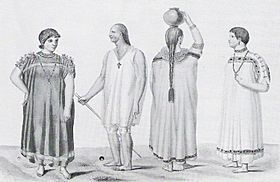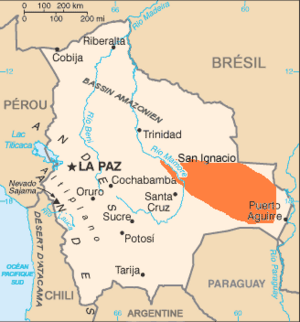Chiquitano facts for kids

Drawing of typical Chiquitano dress,
by Alcide d'Orbigny, 1831 |
|
| Total population | |
|---|---|
| 88,358 (2012) | |
| Regions with significant populations | |
| Languages | |
| Chiquitano, Spanish, Portuguese | |
| Religion | |
| Traditional tribal religion, Christianity |
The Chiquitano people, also called Chiquitos, are an original group of people living mostly in Bolivia. A smaller number of Chiquitano people also live in Brazil. They mainly live in the Chiquitania tropical savanna area of the Santa Cruz Department in Bolivia. Some also live in the Beni Department and in Mato Grosso, Brazil.
In 2012, about 145,653 people in Bolivia identified as Chiquitano. This made them the largest lowland indigenous group in the country. Not many Chiquitanos in Bolivia speak the Chiquitano language today. Many told the census they did not speak it, even as children. The Chiquitano identity grew stronger when different groups were brought together. They had to learn a common language by the Jesuit Missions of Chiquitos.
Contents
What Does "Chiquitano" Mean?
The name Chiquitos means "little ones" in Spanish. People often say this name was chosen by the Spanish Conquistadores. They saw the small doors of the native huts in the region. The Chiquitano people are also known as the Monkóx (plural: Monkoka), Chiquito, or Tarapecosi people.
The Chiquitano Language
Around 40,000 to 60,000 Chiquitano people in Bolivia speak the Chiquitano language. This makes it the fourth most spoken indigenous language there. The Chiquitano language is part of the Chiquito language family. It might even be related to the larger Macro-Jê language family.
Interestingly, men and women speak the language a bit differently. The language is written using the Latin script, which is like the alphabet we use. Several grammar books have been written for Chiquitano. Experts have found four main ways of speaking it, called dialects: Manasi, Peñoqui, Piñoco, and Tao.
A Look Back: Chiquitano History
Many different indigenous groups lived in the Chiquitanía area before the Spanish arrived. The Spanish founded the city of Santa Cruz de la Sierra in 1559. At first, it was far to the east of where it is today. Missionaries tried to connect with the people for about 90 years, but it was not very successful.
The Chiquitos people were strong and well-built, with an olive skin tone. They were farmers and bravely fought against the Spanish for almost 200 years. However, in 1691, they welcomed the Jesuit missionaries. They quickly began to adopt new ways of life. The Chiquito language became the main language for all the people who joined the missions. Soon, about 50,000 people from nearly 50 different tribes were part of these communities.
The most important time for the Chiquitano people was when the Jesuit missionaries arrived. This was from 1692 until they were forced to leave in 1767. The Jesuits created special towns called "reductions." These towns included San Javier de los Piñocas, Concepción, San Ignacio, Santa Ana, San Rafael, San José, San Juan, Santiago, Santo Corazón, and San Miguel. Each town had between one and three thousand residents.
The Jesuits taught that prayer and work were very important. They encouraged people to live in permanent settlements. They also taught them about raising cattle and weaving cloth on looms. This helped the communities grow economically. However, the Chiquitano people also began to work for outsiders during this time. They were even recruited as soldiers in Spanish colonial wars. A Swedish anthropologist named Erland Nordenskiöld said that the Jesuits protected the native people from other Europeans. But he also noted that they lost some of their freedom. After the Jesuits left, it was easier for others to take advantage of them.
After the Jesuits were expelled, some Chiquitanos went to work on ranches and farms owned by mestizos (people of mixed European and indigenous heritage). They often had to work without much choice. Others left the mission villages and lived in smaller camps. From 1880 to 1945, the "rubber boom" brought a new industry to the area. Chiquitano laborers were again needed for this work. The work was very hard, and conditions were difficult. Many people got sick or were injured. Chiquitanos often had to work to pay off debts or were forced to work. They also helped build parts of the Santa Cruz–Corumbá Railway under these conditions.
How Chiquitano People Organize Themselves
In Bolivia, the Chiquitano people have an organization that represents them. It is called the Chiquitano Indigenous Organization (Organización Indígena Chiquitana, OICH). This group is currently led by José Bailaba, who is known as the Cacique Mayor.
In Brazil, the Chiquitano people are working to get their own special indigenous territory. This would be a protected area of land for their community.
See also
 In Spanish: Pueblo chiquitano para niños
In Spanish: Pueblo chiquitano para niños
- Jesuit Missions of Chiquitos
- List of the Jesuit Missions of Chiquitos



